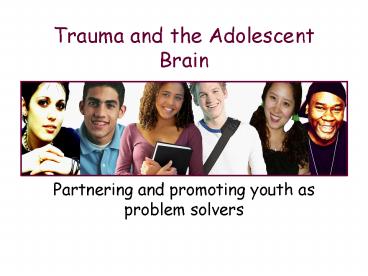Trauma and the Adolescent Brain PowerPoint PPT Presentation
1 / 25
Title: Trauma and the Adolescent Brain
1
Trauma and the Adolescent Brain
- Partnering and promoting youth as problem solvers
2
Trauma and Adolescents
- Almost all children in foster care or juvenile
justice systems have experienced some kind of
trauma.
3
Why does trauma matter?
- Trauma causes disturbances of emotional
regulation, social relationships, attachment, and
communication.
4
Why does trauma matter?
- Trauma typically slows down development in
children and can interfere with all aspects of
the child's functioning.
5
Why does trauma matter?
- Traumatized children often have trouble
concentrating in school, are fearful, and may
seem emotionally detached.
6
Why does trauma matter?
- Children who have been abused or were not
protected from violence often blame themselves
and have trouble trusting others.
7
- Traumatized children may not learn to soothe
themselves and instead manage their anxiety with
reflexiveself-preservation. - Traumatized teenagers often abuse substances to
numb painful feelingsand memories.
8
Trauma packs a punch
- Trauma is related to other behaviors in
adolescents, such as numbing, social withdrawal,
constricted exploration, separation anxiety and
new fears
9
Trauma causes physiological responses
- Depression
- Suicidality
- Aggression
- Sensitivity
- Anxiety
- Difficulty concentrating
http//nctsn.org/nctsn_assets/pdfs/2_Traumatic_Str
ess_4-18-07.pdf
10
http//www.csus.edu/indiv/b/brocks/Workshops/Distr
ict/CCSD.2.06.Handouts.pdf
11
Post Traumatic Stress Disorder
- Sometimes trauma is so significant that it is
diagnosed as PTSD. Adolescents with PTSD are
often fearful, vigilant, and have anxiety.
12
Treatment for Trauma
- Many children require trauma treatment to support
a return to normal development and reduce the
likely continuing effects of trauma.
13
Treatment for Trauma
- Treatment should address withdrawal, aggression,
increased arousal, numbness, anxiety, fear of
abandonment, and attention problems
14
Provider Recommendations
- Providers in regularcontact with adolescents
should include assessments of substance abuse
problems and traumatic stress as part of routine
screening and assessment procedures.
15
Provider Recommendations
- Youth and families should be provided with more
intense treatment options to address the
magnitude of difficulties often experienced by
this population.
16
Provider Recommendations
- An emphasis on management and reduction of both
substance use and PTSD symptoms should happen
early in the recovery process.
17
Provider Recommendations
- Relapse prevention efforts, targeting both
substance and trauma-related cues, should be
provided early in treatment.
18
Provider Recommendations
- School-based treatment programs may represent an
important means of reaching at-risk youth.
19
Suggested Trauma Treatment Components
- Therapeutic relationship that is consistent,
trusting, and collaborative - Stress management skills such as relaxation and
positive self-talk - Emotion regulation skills such as the
identification, expression, and modulation of
negative affect
http//nctsn.org/nctsn_assets/pdfs/4_Treatment_4-1
8-07.pdf
20
Suggested Trauma Treatment Components
- Cognitive restructuring such as recognizing,
challenging, and correcting negative cognitions - Increasing problem-solving, drug refusal, and
safety skills - Social skills training
http//nctsn.org/nctsn_assets/pdfs/4_Treatment_4-1
8-07.pdf
21
Suggested TraumaTreatment Components
- Gradual exposure to achieve desensitization to
trauma reminders - Parental involvement in treatment with the goals
of increasing parenting skills, communication,
and conflict resolution
22
Suggested TraumaTreatment Components
- Psycho-education for both youth and their
families about trauma and substance abuse
problems - Random urine drug screenings
- Adjunct psychopharmacologic treatments
- Possible referral to adolescent self-help groups
23
Strength-Based Treatment
- When dealing with youth of all cultural and
social backgrounds, the approach should
capitalizes on individual, family, and contextual
factors that can serve to promote healthy coping
and adjustment.
24
Strength-Based Treatment
- These factors can include a familys religious or
spiritual beliefs extended families and
available social support networks positive role
models in the community opportunities for
participating in positive recreational, artistic,
or academic activities adolescents built-in
capacity to grow and flourish in the midst of
adversity.
25
Does Medication Help?
- Because people respond to stress biologically as
well as psychologically, medications are
sometimes prescribed to help dampen down symptoms
such as nightmares, difficulty sleeping, and
anxiety.
http//www.nctsnet.org/nctsn_assets/pdfs/effective
_treatments_youth_trauma.pdf

